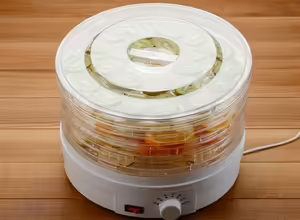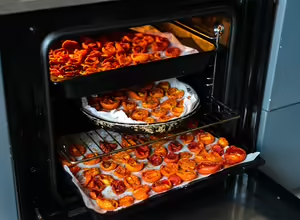Title
Preserve by Drying
Drying or dehydrating food removes water to ensure bacterial growth is reduced to a safe level.
Drying Methods

Electric Food Dehydrators
Food dehydrators are electric appliances that come in various styles. When purchasing, make sure the dehydrator has a fan. The fan blows warm air through and around the food, helping to remove the moisture.

Oven and Microwave Drying
When using an oven to dry, make sure the oven can maintain a low temperature of 140 to 150 F. If so, proceed with drying. Keep the oven door open slightly and have a fan blowing toward the oven to create an environment similar to an electric food dehydrator. Microwave drying is only recommended for herbs.
Sun, Solar, and Vine Drying
Sun, solar, and vine drying are not recommended methods for preserving food in Illinois since the weather, temperatures, and humidity make ideal drying conditions hard to maintain. In areas that can meet ideal conditions, sun drying is acceptable for fruits but not for vegetables or meats.
- Sundried foods also require pasteurization to destroy insects or eggs that may be present.
- Solar drying uses a foil surface to increase the temperature where the food is being dried and shortens drying times.
- Vine drying is used for legumes and other dry beans. Leave the vine alone to let the pods dry and shrivel before harvesting.
Air Drying
This indoor drying method works well for hot peppers and herbs. Create a bundle of hot peppers or herbs. Tie them together with string, and leave the bundles in a well-ventilated area until the food dries completely. Consider covering the food bundles with a paper bag poked with holes to prevent dust from gathering on the food’s surface. Drying outside can lead to a loss of flavor and color.
Title
Drying Fruits and Vegetables
Dried produce is full of flavor, makes tasty snacks, and can be added to a wide variety of dishes, including salads, meat dishes, and hot or cooked cereals.
Pre-treatment
Treating fruits and vegetables before drying improves colors and quality. For fruits that brown when exposed to air, use vitamin C (Ascorbic acid), citric acid, or lemon juice. For small fruits with skins or pits, pre-treat by blanching. For vegetables, pretreat by blanching. Choose a pre-treatment method based on the type of fruit or vegetable you plan to dry.
Pre-treatment Options
For Fruits that Brown
| Pre-treatment | Amount | Action |
|---|---|---|
| Vitamin C (Ascorbic acid) | 2-½ Tablespoons per 1 quart cold water | Prepare pre-treatment mixture. Soak fruit for 10 minutes. Drain and add to dehydrator to begin drying |
| Citric acid | 1 teaspoon citric acid per 1 quart cold water | |
| Lemon juice | 1:1 parts lemon juice and cold water |
For Small Fruits, Fruits with Pits, and Vegetables
| Pre-treatment | Amount | Action |
|---|---|---|
| Boiling | Enough water to hold the amount of produce. | Bring a pot of water to a boil. Add produce, according to dehydrating directions. Remove to very cold water. Place fruits and vegetables on clean cloth to dry, then add to dehydrator. |
Conditioning
After drying, produce needs an additional step called “conditioning”. Since some pieces of fruits and vegetables may be larger or smaller and are at different spots in the dehydrator, the amount of moisture may vary.
- Let dried fruit cool.
- Pack loosely into food-safe jars or covered containers.
- Close the containers.
- Let stand at room temperature for 7 to 10 days.
- Check the container daily for any condensation or moisture. If condensation is visible, add the fruit or vegetables back to the dehydrator until dry.
Conditioning Instructions
- Let dried fruit cool.
- Pack loosely into food-safe jars or covered containers.
- Close the containers.
- Let stand at room temperature for 7 to 10 days.
- Check the container daily for any condensation or moisture. If condensation is visible, add the fruit back to the dehydrator until dry.
Title
Drying Jerky
Drying meat for jerky must include an extra step to ensure all bacteria are destroyed. Meat must be heated to an internal temperature of 160 F before or after dehydrating. Follow a tested recipe.
Need More Details?
For full instructions on preserving food by drying, visit the National Center for Home Food Preservation.